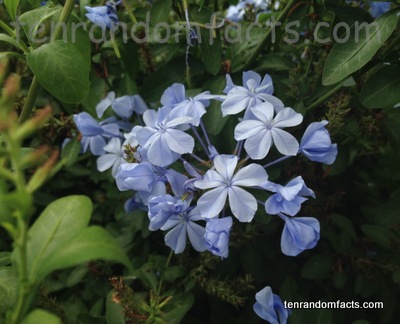Pretty, pretty blue plumbagos.
- ‘Blue plumbagos’ are also known as ‘cape plumbagos’ and ‘cape leadworts’.
- Blue plumbagos are from the family of Plumbaginaceae, which is the family of plumbagos and leadworts.
- Blue plumbagos are decorative perennial flowering bushes that can climb, which are native to South Africa.
- Blue plumbagos can grow up to be 6 metres (20 feet) in height, and sunny and semi-shaded areas are the best spots for them to grow.
- Blue plumbagos have flowers that bloom in different shades of both blue and white that mainly flower in summer and autumn, and sticky hairs that are found near the flowers.
- The scientific name of a blue plumbago is ‘Plumbago auriculata’, with ‘auriculata’ referring to the ear-shaped leaves.
- Blue plumbago flowers are approximately 1.5 cm (0.6 inch) in diameter, and they grown in clusters, and have long tubes at the base of the five petals.
- Blue plumbagos have won the Award of Garden Merit of the Royal Horticultural Society, and are popular in gardens.
- Blue plumbagos often do not flower on the first year after the planting of its seed, from which it is readily grown.
- Blue plumbago leaves are green and shiny and can grow up to 5 centimetres (2 inches) in length, that can attract some insect pests.
Bibliography:
Plumbago auriculta, 2013, Wikipedia, http://en.wikipedia.org/wiki/Plumbago_auriculata
Plumbago auriculta, n.d, Missouri Botanical Garden, http://www.missouribotanicalgarden.org/PlantFinder/PlantFinderDetails.aspx?kempercode=a542








Those sticky hairs always fascinated me as a child when I was at my great-aunties’ house.